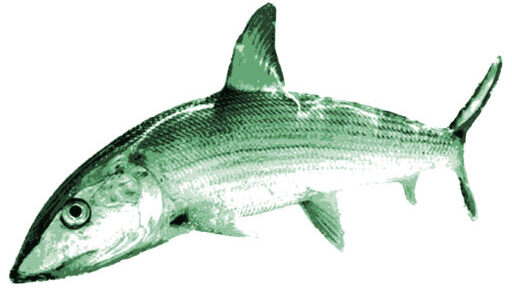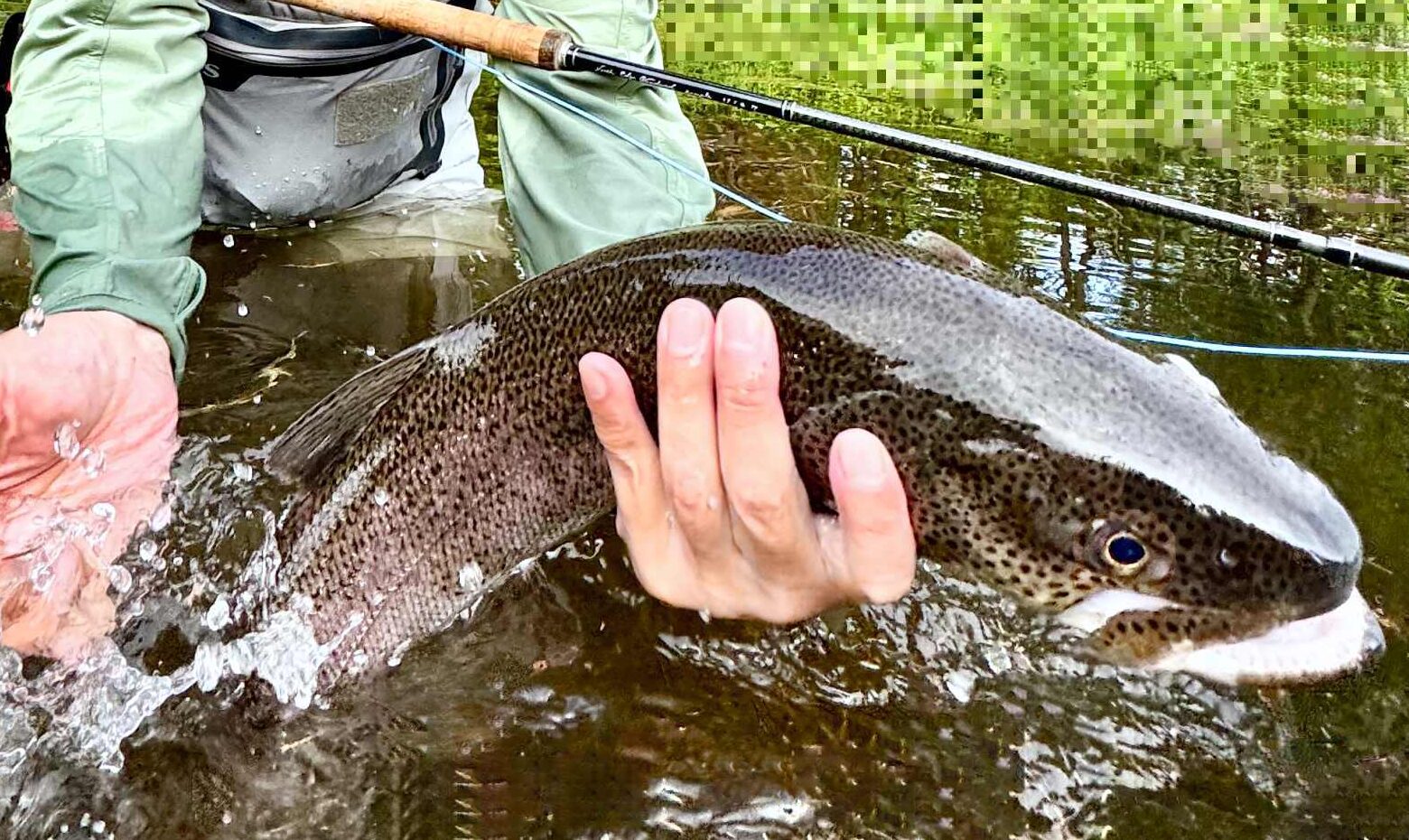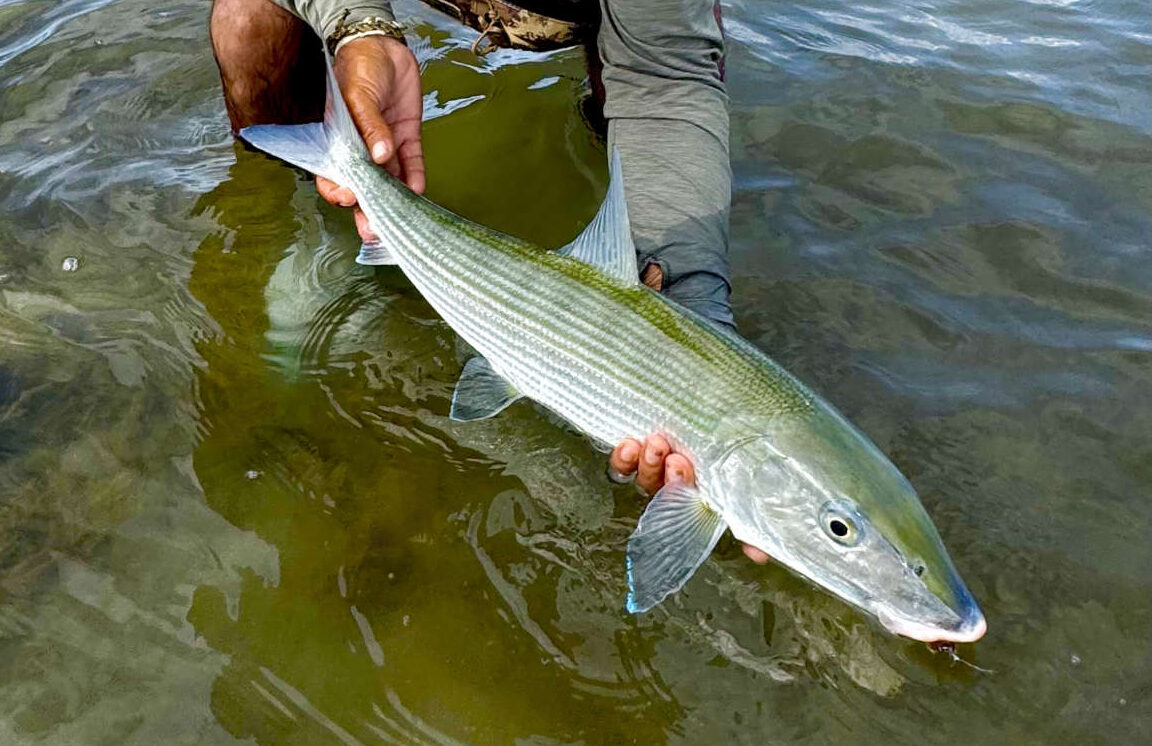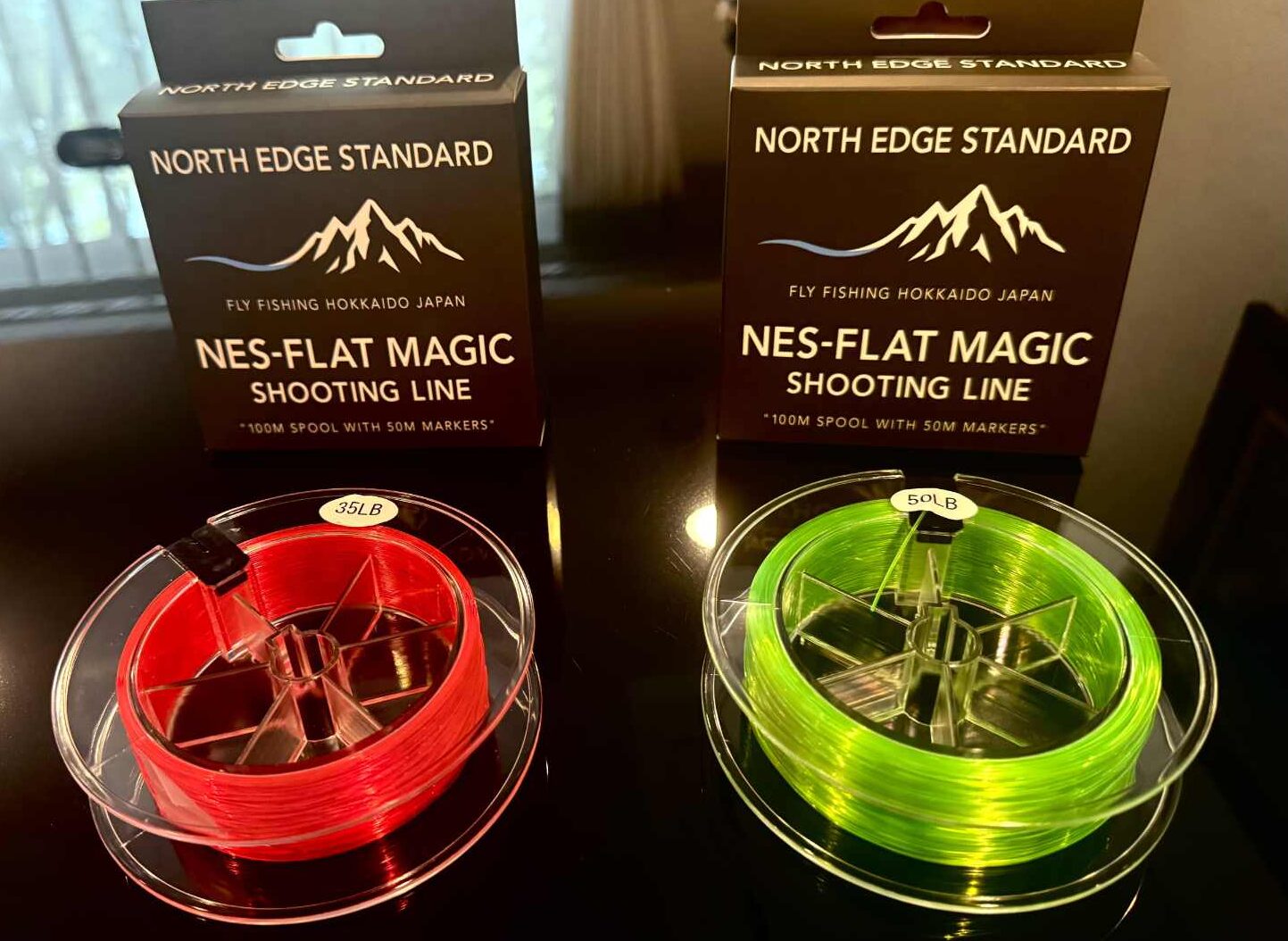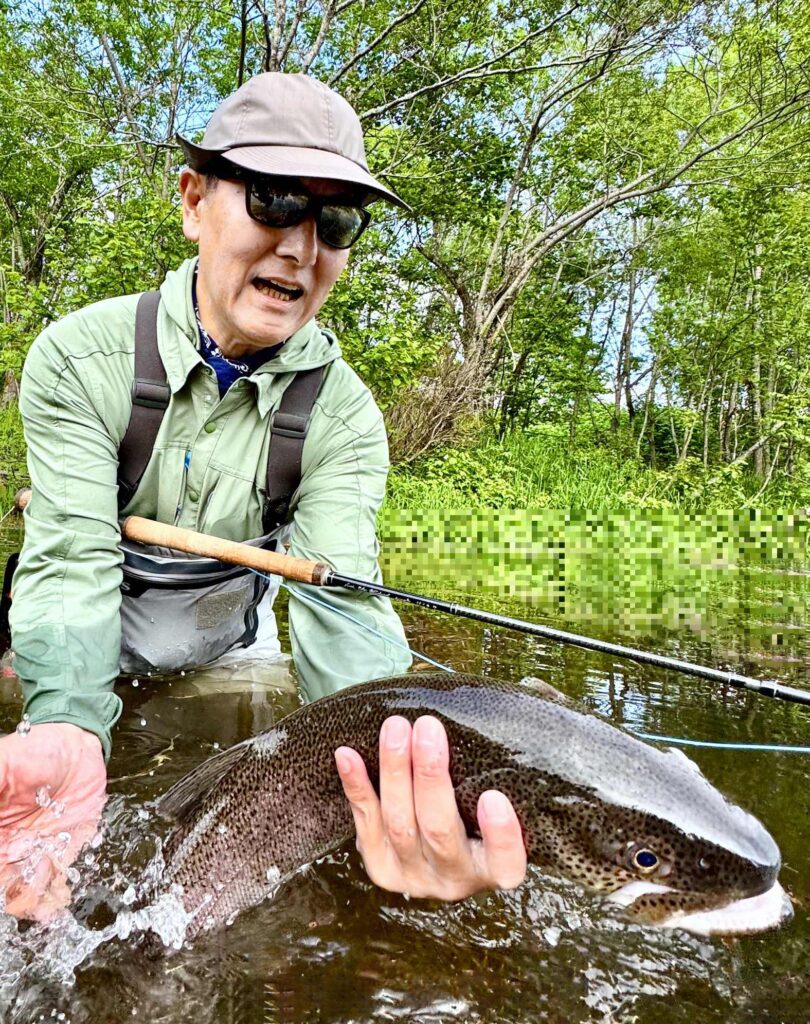
06-15-2025 Scroll down for English
今年も北海道にイトウを追う旅路を続けている。
アメリカに長年住んでいたこともあってイトウのフライフィッシングをやる機会はずっとなくて、僕がこの釣りをやり始めたのはこの3年間。40年前は、「イトウと言えば、水がすごく冷たい晩秋から冬にかけて、強烈にオタクなルアーマンだけにアクセスが許される自分には縁のない魚。」とだけしか見ていなかった。だから、緑萌える季節のいい時に、ましてや僕のような東京に住むフライフィッシャーを相手にしてくれるようなターゲットフィッシュではない、と勝手に決めつけていた。
でも、この3年間イトウ釣りをやって来て、こんな僕にも少しづつイトウの考えていることと、イトウの気持ちが分かって来て、一歩一歩ながらメガイトウとの距離を毎年着実に詰めている自分を感じていた。実は今回の旅行では、その距離感が一気にグーンと縮まった気がする。北海道に住んでいなくても、ゲームプランの立て方がより鮮明に見えてきたのだ。
サケ科イトウ属の“イトウ”と一言で言っても、世界にはその近縁種が5種いる。シベリアンタイメン(Hucho taimen)、ダニューブタイメン(Hucho hucho)、 アムールイトウ(Hucho bleekeri)、 長江イトウ(Hucho ishikawae)、そして我が日本とサハリンだけに棲むイトウ(Parahucho perryi)の5種。その中で、僕が追い求める天塩川水系などに棲む、我が日本のイトウの体高の太さは別格(養殖物では見られないが)で、日本人として誇りに思うし、最恵待遇で護っていくべき貴重な魚であることは間違いない。
このイトウと言う魚、恐ろしく頭がよくて臆病なところも多いのだけど、一旦捕食攻撃モードに入った時の獰猛な野性に満ち満ちた行動は他に類を見ない。それでいて北海道の河川で釣れるイトウにはエレガンスがある。アメマスがどちらかと言うと、スチールヘッドに似るキャラクターであるのに対して、川でのイトウは敢えて言えばアトランティックサーモンのそれを垣間見るところもあるのだけど、畏怖の念を持って正確にイトウと言う魚を語るなら、イトウはイトウ、他の種とは一線を画す単独にして唯一の魚だ。
僕は、イトウは、基本的にスペイフィッシング、スイングでしかやらないのだけど、今回釣り上げた6尾を通して、イトウとの距離感は一気に縮まった。と言っても、数回の成功体験で全貌が分かるほど、生やしい相手でないことも、この3年間で身にしみて体感してきた。 まぁ、それはそれとして、今回、幸運にも深く学べた切り口が3つある。
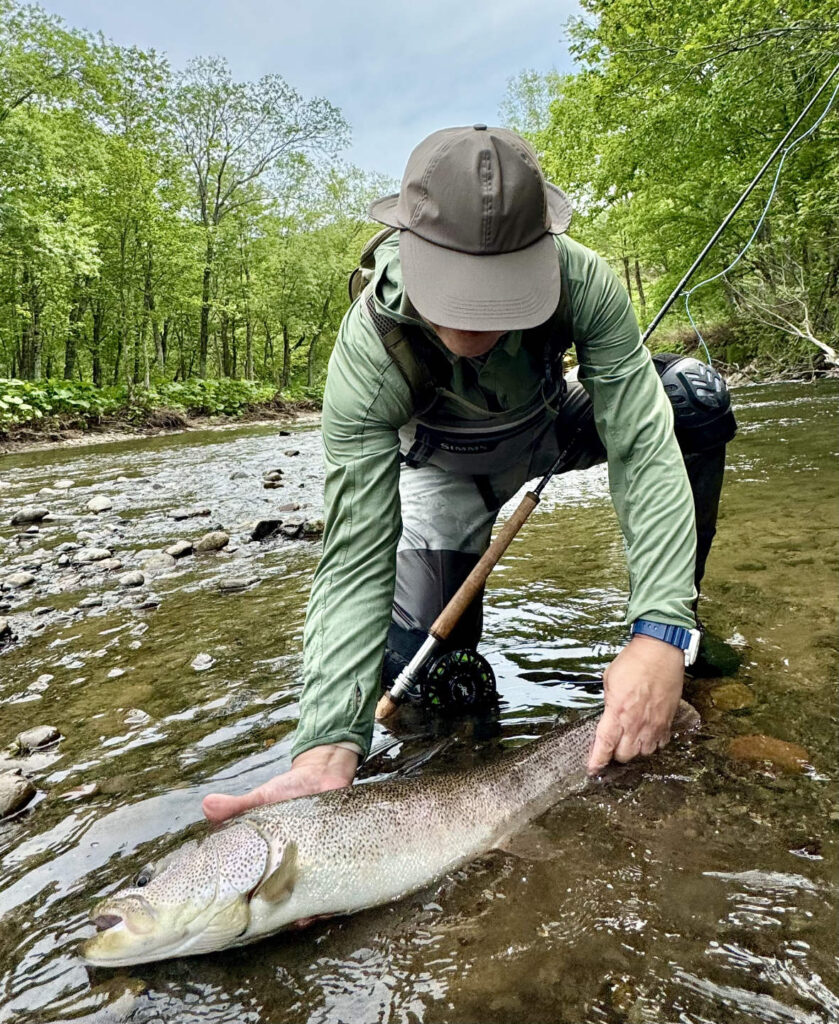
一つは、水中から突き出ている大木の後ろのストラクチャー、巻き返し水流に泳いでいたイトウを見つけ、そこで30分粘って50回位奴の目の前にスイングを通して、ついに口を開かせた一匹 (上の写真)。全く、食い気がないイトウだったけど、口の前5cmにスイングさせることをやり続けている内についに、頭が右に5cm動いて口を開くのが見えた。直後、下流に向け激走して行った一匹だった。この経験は、流れの中のストラクチャーに付いているイトウにスイッチを入れる、そのやり方を学ばせてくれた。
二つ目は、天候情報をゲームプランにビルドインして、綿密な戦略を組むこと。今回、ピーカンに晴れているイトウ釣りには全くよろしくない日々が続いたが、その中でも雨がパラつくタイミングを見計らって、時間帯と場所とスイング方法を詰めて戦略を決めていくと、水面直下でも魚が飛び出してくる状況に出会えることが分かった。イトウは、晴れていて水の濁りがない時ほどポイントが広範囲に拡散し狙い場所の絞り込みが難しくなる。逆に、雨が降って濁りが入り、流れが早くなってくると一気にポイントの絞り込みがやり易くなり、よってヒット確率は一気に上昇する。決め手は、雨が降り始める時に、どこのポイントにいつ立つか、急に川の流れのスピードが増して来た時にイトウは瀬の中のどこにポジションを取るのか、を見極めることだ。
三つ目が、イトウがベイトとする魚(ウグイ)を捉えるシーンをじっくりと観察することができたこと。偶然にも弱った30cmほどのウグイがイトウがいると確信していたポイントを流れている時に、それを観ていたイトウが複数匹いて、僕が全く想像もしていなかった食い方で食いつくシーンをじっくり観察することができたのだ。そこのスポットはすでにフライやルアーで何十回もキャストしていたポイントだったのに、見向きもされなかった場所だ。でも、複数のイトウが全く警戒心なしにそのウグイを捕える様は凄かったし、ものすごく勉強になった。イトウに対して単調に流れるスイングでは、奴らのスイッチを入れるのは絶望に近い、と言う事実を目の当たりにした。次回は、スイング用のストリーマーのマテリアル、デザイン形状を根本的に見直すと共に、シンクティップラインシステムも抜本的に組み直し、特に緩やかな流れにいるイトウに対してデッドにマッチさせる常識外れのリグを用意して挑戦するつもりだ。
イトウは、必ずしも数が少ないから釣れないと言う、ステレオタイプの釣り師が言いたがる、幻の世界にのみ存在している魚じゃない。実は見えていないだけで、場所の選定が間違っていなければ、想像より多くのイトウが目の前にいる時も頻繁にある、と言うのが僕の印象だ。多くのアングラーが当たり前と思ってやっているフライやルアーの動きかし方が、根本的に間違っている点がむしろ大きいはずだ。
因みに、イトウの生息する場所は、いずれも山の神(くま)の密度が極めて高い場所だ。山での歩き方の経験者が同行している事。熊スプレー等の装備に対して万全である事。釣り時間帯について細心の注意が払えることが極めて重要。
僕にとって、北海道のイトウは久しぶりに自分の狩猟本能を目覚ましてくれる魚だ。やるほどに一歩一歩、相手との距離は狭まっていく。そして北海道のイトウは、十分に自分の心を満たしてくれる。
今回は、イトウは充分に成果があったので、明日は、緑萌える渓流にレインボーを釣りに行くこととしよう。
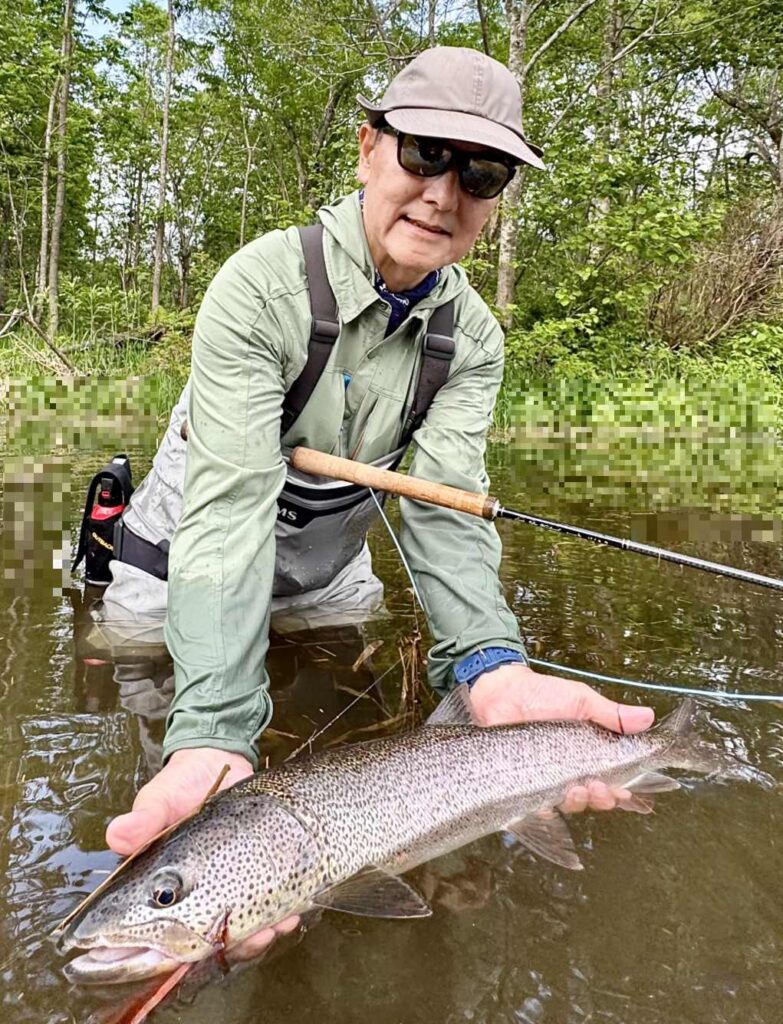
[余談]今回、心底感動したことがあった。それは、北海道の新興ブティックブランドのフライロッドメーカーとして間もなく登場予定の「North Edge Standard」が、年末の市場導入を目指す新作ロッドシリーズのプロトタイプをテストする機会を得た事。素材は、東レのT1100のカーボンクロスをバットからティップまで通しで使い、更にカーボンコンポジット素材でクロス巻き、と言う贅の限りを尽くした作り込み。ご存じの方も多いと思うが、T1100素材を使ったロッド、取り分けルアーロッドはマーケットに出てから久しいが、その素材をロッドのどの部分にどの位使っているかを開示しているメーカーはないので確証はないのけど、推しなべてバット部のみと推定される。これをバットからトップまで通しで使い、尚且つ、クロス巻きカーボンコンポジットで作るとなるとコストがべらぼうに高くなる。「North Edge Standard」のロッドは、5Aグレードのコルクやリールシートのコンポーネンツも最高部材で構成されている。車で言うならフェラーリ。恐らくアメリカのロッドメーカーが同じ素材構成で出したら2000ドル以上(日本で30万円)はするであろうコスト構成のロッドになるが、「North Edge Standard」はこれを戦略価格で投入するようだ。ロッドに硬さは全く感じられず寧ろ柔らかさすら感じる。なのに、凄まじいトルクと言うか粘りがあるので超遠投ができる。11ft 7番のスイッチロッドで投げる時に、ロッドの硬さを感じずに36m越えのキャストが極簡単に成立する。イトウが来てもバット部から吸い込まれるようにロッドが綺麗に曲がり、メーターイトウでも7番ロッドで獲れるロッド、と言ったら信じてもらえるであろうか?僕は、今回の釣行を通して11ft 7番のスイッチロッドをテストし、これで最盛期のフルパワーのイトウを6本釣ったが、ここまでロッドの革命的な進化を体感して感動したのは、自分の50年余のフライフィッシング人生でこれが3回目だ。この新ロッド素材のレポートは、このサイト内の”Fishing Gears”のコーナーで近々に説明する予定です。

Again, I find myself drawn to the northern frontier—Hokkaido—where the elusive Ito (Japanese taimen) calls to me.
Having spent many years living in the U.S., I had never had the opportunity to try fly fishing for this elusive fish, Ito (Japanese Taimen). It’s only been within the past three years that I finally began this journey.
Decades ago, my image of the Ito was fixed: a fish found only in frigid waters during late autumn and winter, accessible solely to the most obsessive lure fishermen—certainly not someone like me. I had completely dismissed the idea that such a fish would ever be within reach, especially not in the lush green season, nor by a fly fisher based in Tokyo.
Yet over these past three years, as I’ve continued to pursue the Ito, I’ve begun to understand its mindset—albeit in small steps. I felt myself gradually closing the distance between us, gaining insights season by season. And on this trip, that distance suddenly shrank. Even without living in Hokkaido, the strategies and timing for targeting Ito have become much clearer to me.
The Ito, belonging to the salmonid genus Parahucho, is one of five related species worldwide: the Siberian taimen (Hucho taimen), the Danube taimen (Hucho hucho), the Amur taimen (Hucho bleekeri), the Yangtze taimen (Hucho ishikawae), and finally the Ito (Parahucho perryi) native to Japan and Sakhalin. Among them, the Ito of Japan—especially those inhabiting systems like the Teshio River—possess a uniquely robust body depth unmatched by hatchery-raised specimens. As a Japanese angler, I take pride in this extraordinary fish, which we should undoubtedly protect and preserve.
The Ito is a remarkably intelligent and cautious predator. But when it enters feeding mode, its wild instincts erupt with ferocity. And yet, despite its power, there is an undeniable elegance in the way it moves through Hokkaido’s rivers. Whereas the amemasu (white spotted sea-run char) resembles the steelhead in temperament, the Ito evokes—if one were to draw a loose comparison—glimpses of the Atlantic salmon. Still, the Ito defies classification. It is wholly unique.
Personally, I only fish for Ito using Spey fishing techniques—swing-style presentations. On this trip, I managed to land six fish, and in doing so, I felt our connection deepen significantly. That said, the Ito remains a formidable and unpredictable target fish—something I’ve come to understand through experience. Still, I was fortunate to uncover three key insights this time.

First, I found an Ito positioned behind a submerged tree structure, resting in the swirling backcurrent. For 30 minutes, I patiently swung my fly across its line of sight—perhaps 50 times—until it finally reacted (a picture above). It hadn’t shown any feeding behavior, but eventually, the fly passed just two inches from its mouth. I saw the subtle shift of its head, and then—suddenly—it struck and darted downstream. That moment taught me how to “switch on” a fish tightly held to structure.
Second, the key is incorporating weather data into your game plan to build a meticulous strategy. This time, there were a string of clear, sunny days — the worst possible conditions for targeting the elusive Ito fish. Still, by timing the brief showers just right and fine-tuning the time of day, location, and swing method, I discovered that even just below the surface, you can encounter situations where the fish break the water. On clear days with no water turbidity, the Ito spreads out across a wide area, making it difficult to narrow down a target spot. In contrast, when rain adds some murkiness and the current speeds up, narrowing down the hotspots becomes significantly easier, drastically increasing your chances of a strike. The deciding factor lies in judging exactly where to position yourself when the rain starts to fall and pinpointing where the Ito will hold in the riffles as the river’s flow rapidly increases.
Third, I had the rare opportunity to observe how Ito feed on their natural prey, particularly ugui (dace). By chance, I watched a weak 12 inches ugui drift downstream through a current, which we recognized as a known Ito holding spot. Multiple fish emerged to feed, striking in ways I had never imagined. It was a pool we had fished many times before on that day—with zero interest from the fish. And yet, watching them pursue the ugui so naturally and without hesitation was enlightening. It revealed that a monotonous swing presentation often fails to trigger a response. For my next trip, I plan to rethink my entire streamers approach—from fly materials and design to sink-tip line systems—especially for targeting Ito in slower water. I aim to create a presentation that mimics their prey with uncanny precision.
The Ito is not an unreachable “phantom fish” simply because it’s rare. In fact, they’re often right in front of us—we just don’t realize it. The issue lies more in our conventional tactics. Much of the fly and lure presentation commonly used is, in fact, fundamentally flawed.
For me, the Ito of Hokkaido has reawakened a deep hunting instinct I hadn’t felt in years. With each attempt, I move one step closer. And when I finally connect, it brings a profound sense of satisfaction.
Since this trip brought such rewarding encounters with Ito, I’ll be heading to the mountain streams tomorrow in search of rainbows amid the lush greenery.

[Postscript]
I had a truly moving experience this time. It was the opportunity to test the prototype of a new fly rod series from “North Edge Standard,” a boutique fly rod brand soon to launch from Hokkaido. They’re aiming to release it by the end of the year.
The rod is crafted with utmost luxury, using Toray’s T1100 carbon cloth continuously from the butt to the tip, and reinforced with cross-wrapped carbon composite materials. As many of you might know, while the rods especially the lure rods using T1100 have been on the market for some time, no manufacturers disclose exactly how much of that material is used in which part of the rod. Based on assumptions, it’s generally believed that only the butt section utilizes it. But this rod uses T1100 throughout the entire blank, from butt to tip, and on top of that, adds cross-wrapped carbon composite—making the production cost sky-high. The “North Edge Standard” rod also uses top-tier materials for components like the 5A grade cork and reel seat. If this were a car, it’d be a Ferrari. If an American rod maker produced a rod with this same material configuration, the price would easily exceed $2,000. However, “North Edge Standard” appears to be introducing it at strategical price points.
Despite the absence of any stiffness, the rod feels soft and remarkably supple. Yet it generates massive torque and resilience, enabling exceptional long-distance casting. When casting the 11ft, 7-weight switch rod, it easily clears 120 feet without feeling stiff at all. When 30 inches Ito strikes, the rod bends beautifully from the butt, as if absorbing the fish’s pull—and believe it or not, even a 40 inches long Ito can be landed with this 7-weight rod. Through this trip, I tested the 11ft 7wt switch rod and landed six peak-season, full-power Ito. Feeling such a revolutionary evolution in rod performance—this is only the third time in my 50+ years of fly fishing that I’ve been moved like this.
A more detailed report on this new rod material will be published soon in the “Fishing Gears” section on this site.
